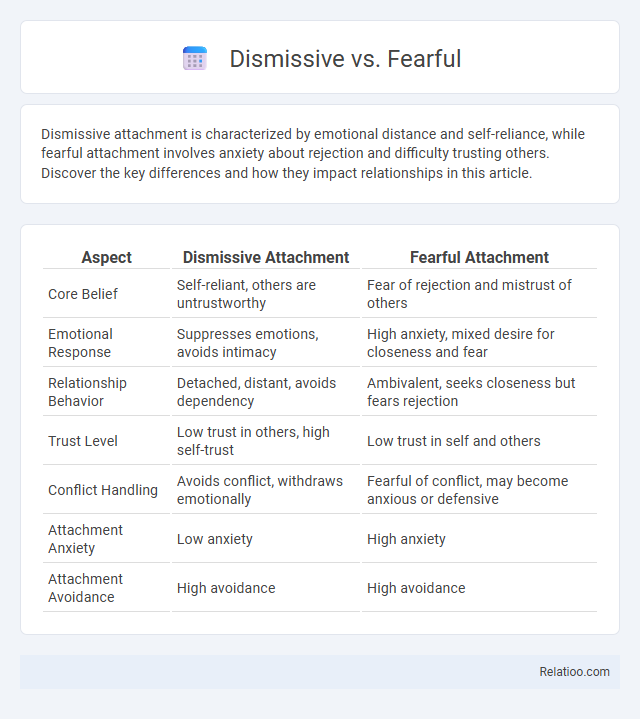Dismissive attachment is characterized by emotional distance and self-reliance, while fearful attachment involves anxiety about rejection and difficulty trusting others. Discover the key differences and how they impact relationships in this article.
Table of Comparison
| Aspect | Dismissive Attachment | Fearful Attachment |
|---|---|---|
| Core Belief | Self-reliant, others are untrustworthy | Fear of rejection and mistrust of others |
| Emotional Response | Suppresses emotions, avoids intimacy | High anxiety, mixed desire for closeness and fear |
| Relationship Behavior | Detached, distant, avoids dependency | Ambivalent, seeks closeness but fears rejection |
| Trust Level | Low trust in others, high self-trust | Low trust in self and others |
| Conflict Handling | Avoids conflict, withdraws emotionally | Fearful of conflict, may become anxious or defensive |
| Attachment Anxiety | Low anxiety | High anxiety |
| Attachment Avoidance | High avoidance | High avoidance |
Understanding Attachment Styles: Dismissive vs Fearful
Dismissive attachment style is characterized by emotional detachment and a strong desire for independence, often leading individuals to avoid intimacy and suppress feelings. Fearful attachment combines a fear of rejection with a craving for close relationships, causing anxiety and inconsistency in emotional connections. Understanding these distinct patterns helps clarify how early relational experiences shape adult behavior and relationship dynamics.
Key Characteristics of Dismissive Attachment
Dismissive attachment is marked by a strong emphasis on independence, emotional distance, and a tendency to downplay the importance of relationships. Individuals with this style often suppress their feelings and avoid intimacy, valuing self-sufficiency over emotional connection. Key characteristics include discomfort with closeness, difficulty expressing vulnerability, and a preference for maintaining control in relationships.
Defining Fearful Attachment: Core Traits
Fearful attachment is characterized by a deep-seated fear of rejection combined with a strong desire for closeness, often leading to ambivalence in relationships. Individuals with this attachment style struggle with trust and tend to avoid intimacy despite craving emotional connection, stemming from past experiences of inconsistency or trauma. Core traits include anxiety about abandonment, low self-worth, and simultaneous push-pull behavior in romantic or social bonds.
Emotional Patterns in Dismissive and Fearful Types
Dismissive attachment is marked by emotional detachment and a tendency to suppress feelings, leading to defensive self-reliance and avoidance of intimacy. Fearful attachment involves a conflicting desire for closeness combined with fear of rejection, resulting in anxiety and emotional instability. Both types struggle with trust but differ as dismissive individuals minimize emotions while fearful individuals experience intense emotional turmoil.
Relationship Dynamics: Dismissive vs Fearful Attachment
Dismissive attachment involves a strong desire for independence and emotional distance, leading to challenges in expressing vulnerability, while fearful attachment combines a fear of rejection with a deep need for closeness, creating intense internal conflict. Your relationship dynamics can become strained as the dismissive partner avoids intimacy, which heightens the fearful partner's anxiety and fear of abandonment. Understanding these contrasting patterns helps improve communication and foster healthier emotional connections.
Origins and Causes of Dismissive and Fearful Styles
Dismissive and Fearful attachment styles both originate from early interactions with caregivers marked by inconsistency or emotional unavailability, leading to insecurity in relationships. The Dismissive style develops as a defense mechanism where individuals suppress emotional needs to maintain independence and avoid rejection, often stemming from neglect or a lack of responsive caregiving. Fearful attachment arises from trauma or fear of abandonment coupled with a desire for closeness, causing conflicting emotions that impact Your ability to trust and connect comfortably with others.
Communication Styles: Dismissive vs Fearful Individuals
Dismissive individuals exhibit a communication style characterized by emotional distance, reluctance to share feelings, and a tendency to downplay the importance of close relationships, often appearing self-reliant and indifferent. Fearful communicators struggle with expressing themselves due to anxiety and fear of rejection, leading to avoidance or mixed signals that confuse message intent. Understanding Your communication style can improve interactions by recognizing these distinct patterns and adapting strategies to foster clearer, more empathetic exchanges.
Impact on Romantic Relationships
Dismissive attachment often leads individuals to prioritize independence, causing emotional distance and challenges in forming deep romantic connections. Fearful attachment combines a desire for closeness with a fear of rejection, resulting in unpredictable behavior that can confuse partners and strain relationships. Understanding Your attachment style helps navigate intimacy issues and fosters healthier communication to improve romantic relationship dynamics.
Healing and Growth for Dismissive and Fearful Attachments
Dismissive attachment often results in emotional distance, but focused healing can foster vulnerability and deeper connections, promoting personal growth. Fearful attachment tends to cause anxiety and mistrust, yet embracing therapeutic practices helps you build secure relationships and self-awareness. Understanding your attachment style is essential to breaking negative patterns and achieving emotional balance.
Strategies for Healthy Relationships with Dismissive or Fearful Partners
Navigating relationships with dismissive or fearful partners requires clear communication and consistent emotional support to build trust and reduce anxieties. You can foster a healthier connection by encouraging vulnerability, respecting boundaries, and reinforcing positive interactions that validate your partner's feelings. Developing patience and understanding helps both partners move toward secure attachment and greater emotional intimacy.

Infographic: Dismissive vs Fearful
 relatioo.com
relatioo.com